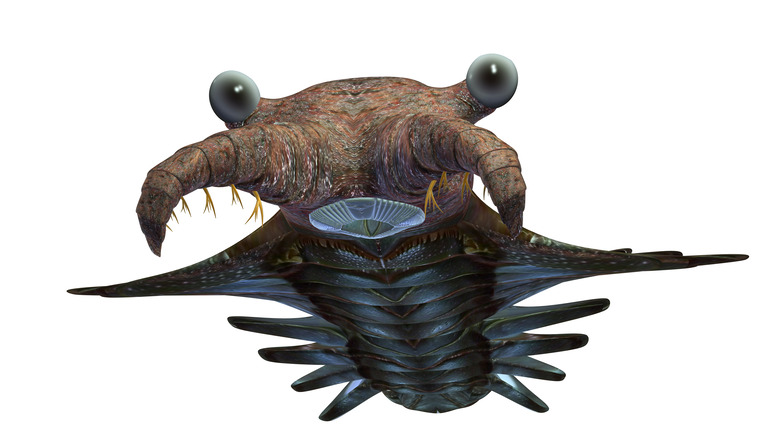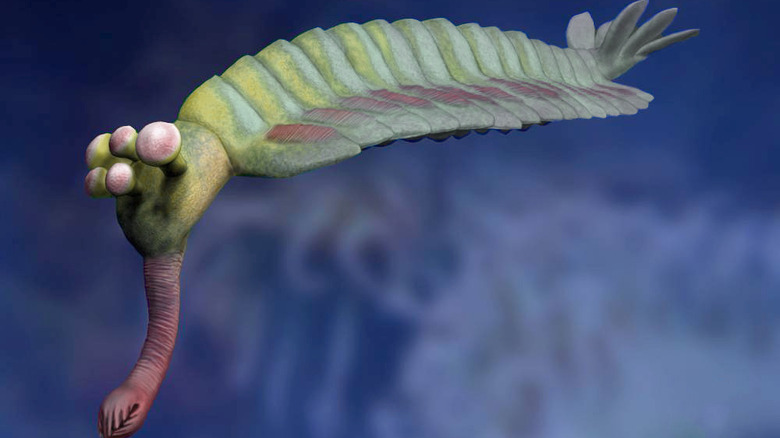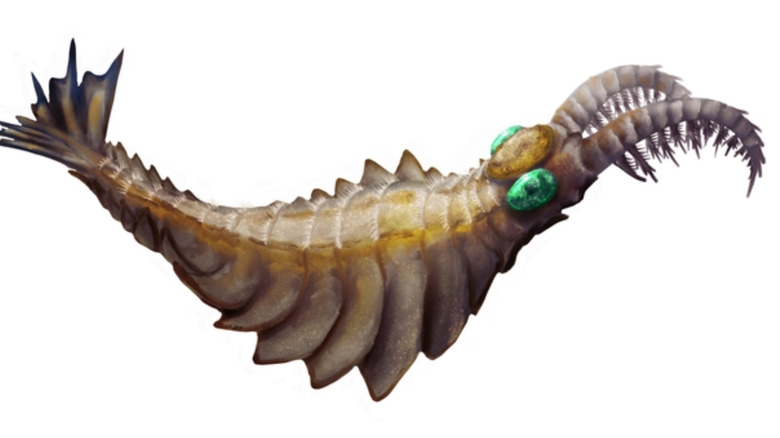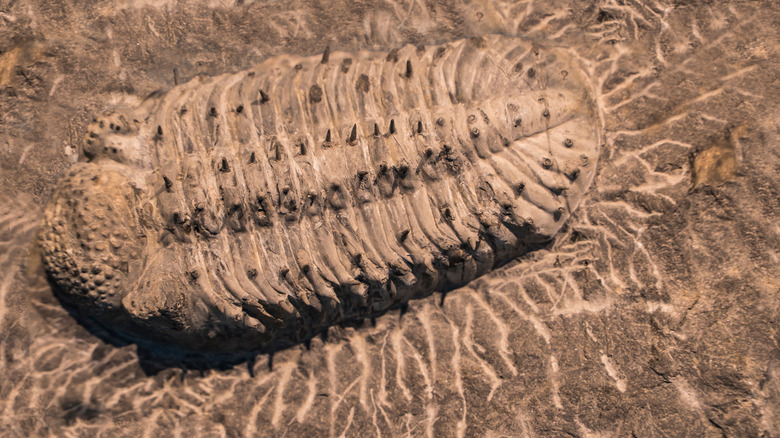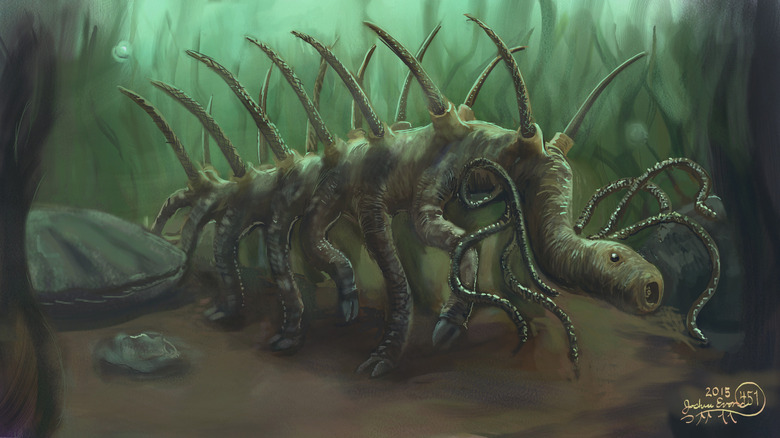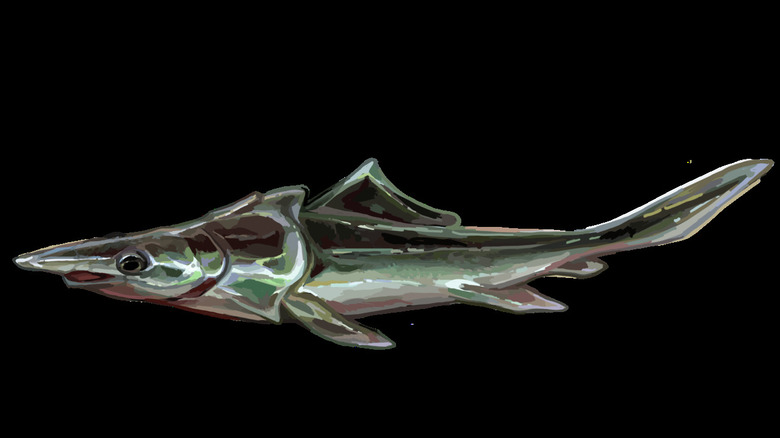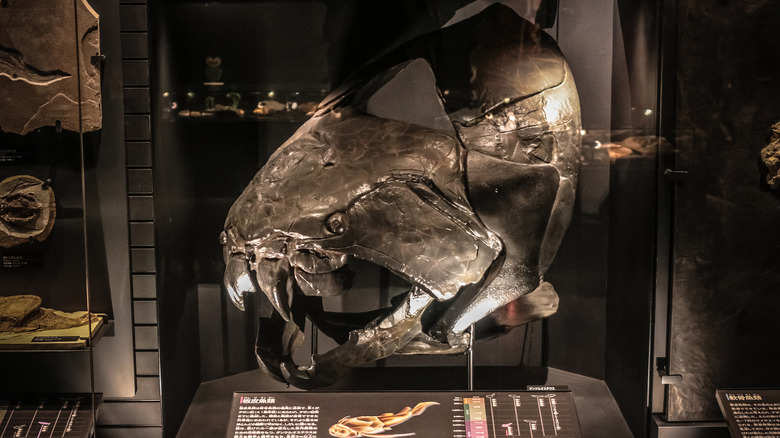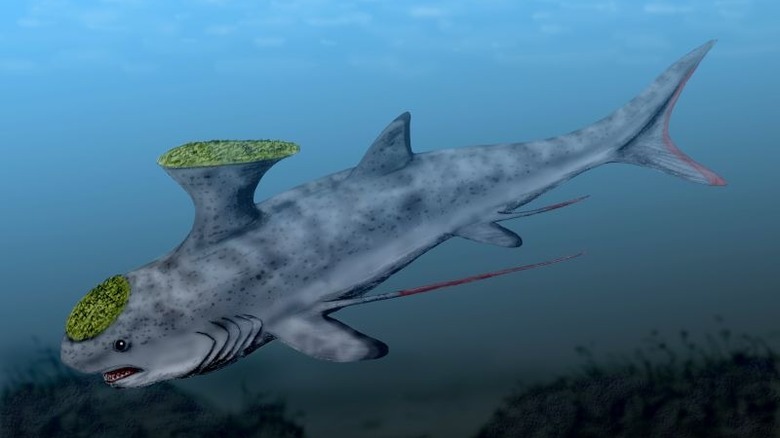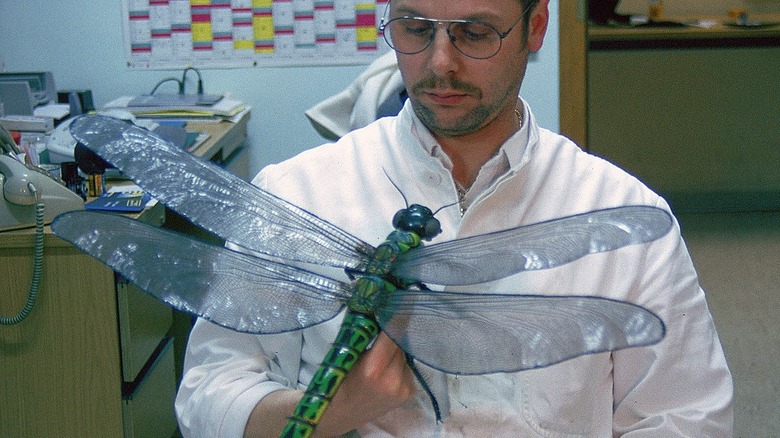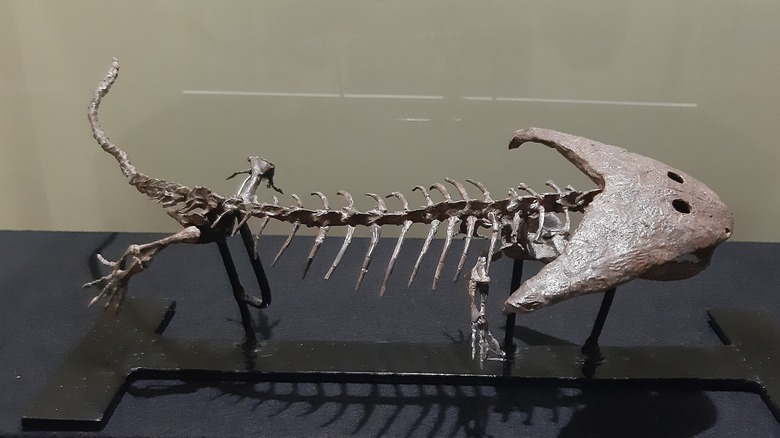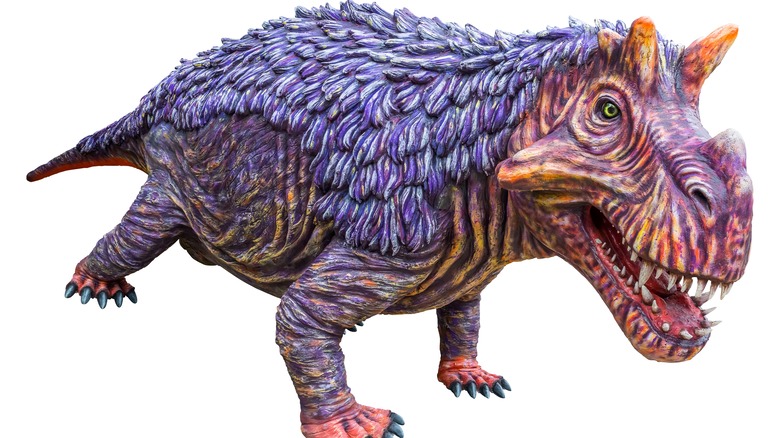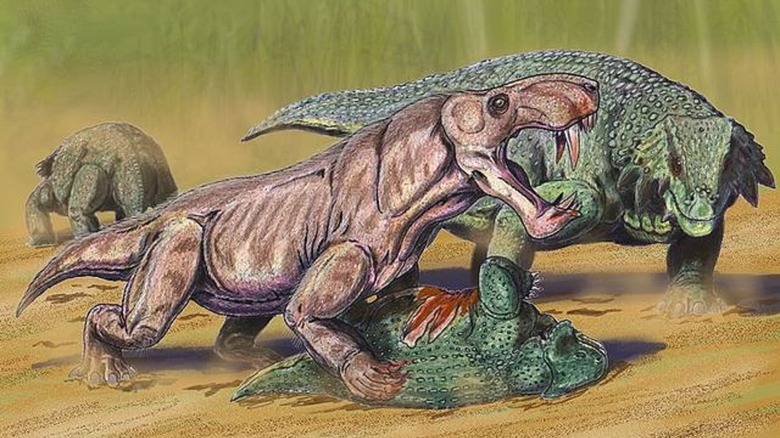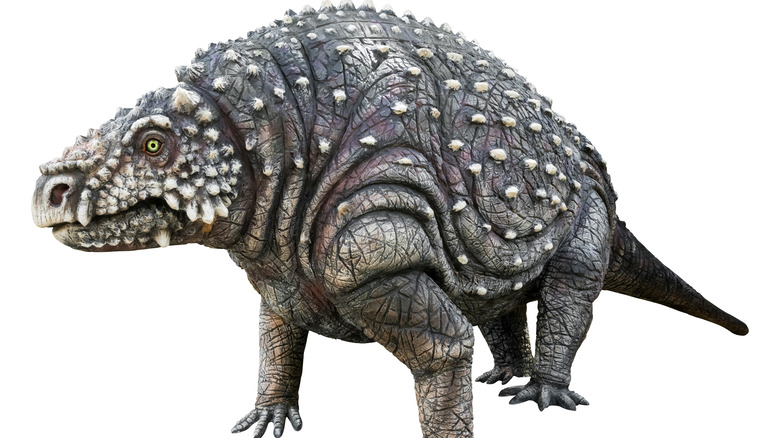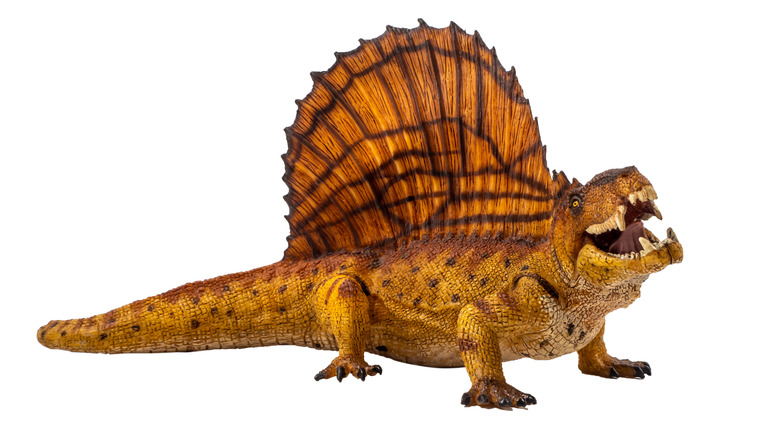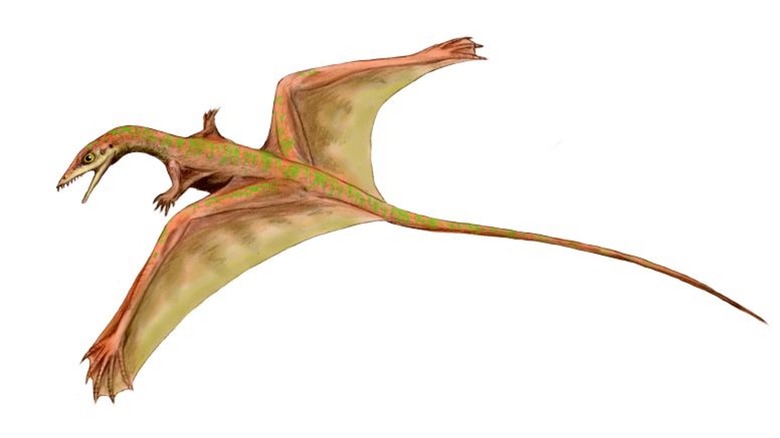Strange Creatures Who Roamed The Earth Before The Dinosaurs
If you asked most people to name the oldest forms of life that have existed on Earth, it is likely the first response you'll get back are dinosaurs. Yes, dinosaurs are old. Britannica tells us that they thrived during the Mesozoic Era between 252.2 and 66 million years ago. They ruled for a long time and a long time ago.
Mesozoic as a word is from Greek which translates to "middle life." Just the term alone implies that there was life before the dinosaurs. Indeed, before the Mesozoic there was the Paleozoic Era, which means "ancient life." To make an analogy with operating systems, if modern life and the dominance of mammals (Cenozoic Era) is Life 3.0, and the dinosaurs were Life 2.0, then what was Life 1.0?
The Paleozoic, Mesozoic, and Cenozoic (our era) are divided into geologic periods. The Paleozoic for example is split into six periods covering events from 541 to 252 million years ago. It starts with the Cambrian period when life greatly diversified and evolved in the seas. As the Paleozoic progressed into new eras life moved onto land, finally coming to a close with the disastrous Permian extinction which killed 90% of life on Earth. In those 289 million years of Life 1.0, natural selection and evolution produced some strange creatures that would fit more into a science fiction or fantasy novel than in animal documentary today. Let's take a look at some of them.
Opabinia
What has five eyes, a claw on its face, and a backward mouth? If you guessed Opabinia, then you must be a paleontologist. Opabinia, according to Live Science, swam the seas of the Cambrian (541 to 485.4 million years ago) and is weird, even to scientists. The creature in the most vague sense looked like a shrimp or even a lobster with 15 segments on an elongated body without legs. It seemed to move around through the use of undulating lobes on the side of its body, but as "Early Life" points out, it is hard to tell if the thing swam freely through the water or if it skipped along the seafloor. To make it even stranger, it also had its five bulbous, insect-like eyes that sat on its head. Oh, yes. Then there was a long arm about one third the size of the body that was right on the head with a claw or pincer at the end. It is likely that this Opabinia grabbed food with the claw and then brought it back around to the mouth, which faced toward the rear of the body. If this sounds terrifying, don't worry; you'd be safe swimming with Opabinia. It was only three inches long.
Scientists have, for a long time, asserted that Opabinia was a one-off type of creature without any other relatives. However, in 2022 researchers have placed a misclassified sea creature, Utaurora comosa, as being a relative that lived several million years after Opabinia.
Anomalocaris
The top predator of the Cambrian seas was an over three-foot-long shrimp-like creature called Anomalocaris. As National Geographic describes, this animal featured a flattish body with undulating lobes that propelled it through the water. It spotted prey with two periscope-like eyes and seized it with two spiked claws that it would use to thrust the meal into a squarish mouth. The mouth itself did not have teeth as we know it today. Nature describes the orifice as having "tooth-like serrations."
While scientists have known that Anomalocaris was a top predator, it was only in 2011 that they learned its full effectiveness as a hunter. Fossils in Australia discovered in the Emu Bay Shale, known for preserving soft body parts, show that Anomalocaris had exceptional eyes. It had hexagonal lens on each eye, which is the standard set for the arthropods (insects and crustaceans) to which it is related. What is more, Anomalocaris had over 16,000 lenses on each eye and possibly higher. Paleontologist John Paterson of the University of New England in Australia who had been one of those who made the discovery commented to Nature, "This is a lot [of lenses]. The common housefly has only 3,200 and most ants have fewer than 1,000." Dragonflies have up to 28,000 lenses in each eye — and extraordinary eyesight — but they are according to Paterson, "the freaks of the arthropods."
Trilobites
Trilobites were shelled invertebrates which no longer exist, but were one of the most common animals during the Cambrian period. According to Britannica, these arthropods were shaped into three lobed segments and very likely developed even before the Cambrian Period, perhaps over 600 million years ago. There are no comparable animals to these today (except maybe if you flip over a horseshoe crab and squinted really hard, or better yet a pill bug.)
Trilobites came in many species and sizes, with some reaching up to 18 inches in length at an estimated 10 pounds. In addition, although all trilobites, like all shrimp today, have a similar body type, their behaviors were wildly different. Some for example just got by eating plankton, while other scavenged, and still some others actively hunted.
The trilobite heyday was the Cambrian when they were possibly the most common animal of the ancient seas. In subsequent eras, they slowly died out until they became almost nonexistent by the end of the Paleozoic Era.
Hallucigenia
Hallucigenia is regularly touted as the weirdest animal known to science. National Geographic tells us it was given its name in 1977 by the British paleontologist Simon Conway-Morris because of what he called its "bizarre and dream-like quality." And once you see this pencil-like worm with seven tentacles (with mouths) and seven spines, you'd probably agree that Hallucigenia belongs in a Pink Floyd movie.
Hallucigenia was small, up to 1.9 inches in length, and lived in the Cambrian seas. Because of its strangeness, more information about it is hard to fathom, but scientists have given it the post-doctoral try. For example, one problem was trying to figure out where its head was. In 2015, however, there was a breakthrough when researchers found what seemed to be a little set of circular teeth indicating that they at last found the head of Hallucigenia. As one of the researchers from the University of Cambridge, Dr. Martin Smith, was quoted saying, "The early evolutionary history of this huge group is pretty much uncharted." This is well stated, considering that there was so much trouble figuring out which side of Hallucigenia was up.
Brindabellaspis
During the early Devonian period, about 400 million years ago, there was a fish that was unlike any other. Brindabellaspis was a fish, which according to Sci News, had eyes right on the top of the head. In fact, the nostrils were situated where the eye sockets were. The fish also had such an elongated snout that it has been compared to a platypus. The mouth, as a result, was very far forward.
Brindabellaspis was a placoderm. Placoderms, as described by Britannica, were early jawed fishes that featured a plating around their head and also the trunk. These fish were unrelated — or very distantly related — to today's bony fish, and while extinct today, they were common during the Devonian.
Scientists believe that Brindabellaspis was a bottom dweller based on the location of its eyes, which can look for danger from above, but also because it seemed to have a pressure sensing system on the snout. This would allow the fish to locate prey by probing into the sediment.
Dunkleosteus
Dunkleosteus was an ancient armored fish that would give anybody nightmares. The Cleveland Museum of Natural History, which has the best preserved skeletons of this predatory armored fish, notes that it reached up to 20 feet in length and had self-sharpening bone protrusions that were neither fang nor tooth, but something far more frightening. Basically, imagine a giant fish with a guillotine at the end that would laugh at a barracuda.
There is little doubt that Dunkleosteus was not the peaceable type. It certainly wasn't a picky eater. According to the BBC, fossilized remains show that it ate sharks, rays, and was even its own kind. It also seemed to suffer from bowel troubles since fossils of it are often shown with semi-regurgitated remains. That aside, there are details about this ancient monster that we usually don't get from the fossil record. First, fossilized pigments show that Dunkleosteus was probably darkly colored on the top and silver on the bellow. Second, Dunkleosteus may have been one of the first fish to exist in different sexes.
Akmonistion
Sharks as a group of animals are ancient, and some of the most ancient ones were very strange. According to the U.K.'s Natural History Museum, sharks first appeared about 450 million years ago during the Late Ordovician period as cartilaginous fish. Fast forward a 100 million years to the Carboniferous Period, and sharks had begun to take shape as we know them today with some weird modifications.
One exception is the foot-long Akmonistion. As described by "Vertebrate Paleontology," this shark had a structure on the shoulders in lieu of a primary dorsal fin which they described as looking like a "shaving brush." "The First Vertebrates" adds more color, describing it as a "shaving brush mounted on an anvil." Atop the structure there were toothy denticles which also were found on the shark's forehead. Since this dorsal structure has only been found in males of the species, it is supposed that its purpose had to do with mating and display.
Meganeuropsis
The Carboniferous and Permian Periods, from about 350 million years ago, had an environment different from Earth today. As explained by "Life: the Science of Biology," oxygen levels on earth were about 50% higher. This allowed for the development of mega-insects. And there was no bigger insect than Meganeuropsis.
Meganeuropsis was a dragonfly, and from its fossils, it looks like one that you might see in your backyard today, though a touch bigger. According to Harvard Magazine, one species of Meganeuropsis from the Permian had a wingspan of two and half feet. The University of Nebraska — Lincoln, estimates its weight to be about a pound — that is, about the weight of a crow. It is likely that Meganeuropsis feasted on other insects in the air or preyed on small amphibians from the ground. The insect, however, has been debated, since, with a modern dragonfly, the way oxygen diffuses through its body gives it an upper size limit. This had led to support for theories about increased oxygen levels during these time periods.
Diplocaulus
The Permian Period saw a great diversity in the number and types of amphibians, and some, like Diplocaulus, were just weird. This species lived from the late Carboniferous to the early Permian and, according to "Vertebrate Paleontology," stood out from the crowd of other Mesozoic amphibians by having a boomerang-shaped head with eyes on top. It is likely that this three-foot amphibian preyed on fish and other riverine fauna (per "Rise of the Reptiles").
The "Book of Life" notes that after the discovery of this ancient amphibian, it was supposed that the head was sized that way for display, or maybe it had a defense function and would prevent a larger predator from swallowing it since the large head would get caught in the throat. This may be true, but it seems that the boomerang head also served another important purpose. Scientists conducted an engineering study and found that the head could have be used as an airfoil, or more literally a hydrofoil: it could move through the water more efficiently. For example, if a Diplocaulus is lying on the bottom of a river, it may spot a fish with the eyes on top of its head. Then it could lift up the head slightly which would create lift within the current in one swift movement. It could then ambush its prey from below. Given that, it is worth mentioning that aside from looking like a boomerang, the head is also similar to that of a stealth bomber.
Estemmenosuchus
By the end of the Paleozoic, life had colonized the land and had grown in diversity. One of these strange land creatures was the therapsid, Estemmenosuchus. What is a therapsid, you ask? Therapsids were a kind of reptile that lived during the Permian and into the Mesozoic Era, according to Britannica. This is the lineage of animals that gave rise to the mammals. These animals were known to be one of the first groups to have a diversity of teeth — incisors, canines, molars, and so on.
Estemmenosuchus was no exception. "The Origin and Evolution of Mammals" describes it as having large saber-like canines. It was also large, being about the size of a small car, and weighed nearly half a ton. The funny thing is that at least according to "Prehistoric Giants," scientists can't quite agree if this creature was a herbivore or carnivore. Its canines and sharp incisors say it could hunt, but it also had a robust body form that seemed perfect for digesting plants. "Beasts Before Us" splits the difference and asserts Estemmenosuchus ate both plants and meat, making it an omnivore. Yet the strangest feature of Estemmenosuchus is that its face and head had a pattern of bony ridges or horn-like protuberances that seemed to explode outward in all directions. It is speculative, but these protuberances could have been used for defense, display, or contests of domination, like head-butting.
Inostrancevia
Possibly the top hunter at the end of the Paleozoic Era during the Permian was Inostrancevia. This genus had several species with some, according to "Sabertooth," growing to almost 10 feet in length, and they also sported pretty large, saber-like canines. "Mammalian Evolution, Diversity, and Systematics" Inostrancevia was a member of a group of therapsid predators called the gorgonopsians. As the University of California, Berkeley tells us, this group, unlike other animals of the transition between reptiles to later forms of animals, had longer legs that were positioned directly under the body. This allowed a faster gait than what a reptile with sprawled out limbs could achieve.
This likely means that Inostrancevia were active, high-energy hunters. It has been theorized that some of the gorgonopsians, including Inostrancevia, may have hunted in packs. If that was the case, then these animals may have been endothermic (warm-blooded, that is) where temperature is regulated from inside the body. Inostrancevia is also the largest known member of this group, detailed in "Vertebrate Evolution" as being up to 660 pounds and 11 feet in length. Truly a frightening predator both then and now.
Scutosaurus
One of the main items on Inostrancevia's menu may have been Scutosaurus. Despite the sound of the name, Scutosaurus was not a dinosaur. Rather, it belonged to a class of animals termed by "Cowen's History of Life" as "parareptiles" being related to anapsid reptiles such as tortoises and turtles (via Nature). Scutosaurus was the size of a hippo and armored with bony plates for protection. This was probably a strong defense against the saber teeth of the gorgonopsians. This animal was also a herbivore, as described by the "Encyclopedia of Dinosaurs and Prehistoric Life," with its teeth designed for chewing as well as a (probably) large gut for digestion of plant matter. Aside from the bony plates, older scutosaurus as well as any of its kindred group called pareiasaurs, had horned projections in and about the face. It is supposed that these developed not only for defense, but also possibility for use in mating competitions of dominance.
Scutosaurus disappeared completely with the disaster at the end of the Permian.
Dimetrodon
Perhaps the most famous beast from before the age of dinosaurs, and also often confused with one, is the Dimetrodon. According to Britannica, it was a fairly large Permian Period predator growing to 11.5 feet. Yet the most unique feature of this animal was the sail-like structure on its back. This was formed by elongated vertebral spines that were connected to one another with a membrane. It is generally believed that this sail acted as a form of thermoregulation, although the American Museum of Natural History also says it could have been used as a display to attract mates or to frighten predators or rivals.
Dimetrodons were, as explained by Smithsonian, synapsids, a group to which mammals belong. Synapsid as a term refers to hole openings in the skull; synapsids, including mammals, have one. (For reference, dinosaurs are diapsids and have two.) Just like mammals, they also had different kinds of teeth; think about how humans have molars, canines, and incisors — this is a common trait among mammals. In fact, Dimetrodon belonged to a group called sphenacodontians, the group to which the distant direct ancestor of mammals belongs. So as improbable as it sounds, maybe you have a touch of Dimetrodon in you.
Sharovipteryx
While the Age of Dinosaurs is considered to be the Mesozoic Era — composed to the Triassic, Jurassic, and Cretaceous periods (via USGS) — dinosaurs did not immediately dominate life right after the mass extinction that ended the Paleozoic Era. According to National Geographic, dinosaurs first evolved during the late Triassic period. Millions of years elapsed during the very early Mesozoic before dinosaurs. This gave rise to some strange creatures, and one of them is the flying reptile Sharovipteryx.
"Triassic Life on Land" tells us that this animal is known from one skeleton which shows a 9.5 inch body of a reptile like creature. What made it most unique is that it had a membrane connected from the rear part of the body to the back legs. This presumably was to allow sharovipteryx to fly or glide. Just how it did that is explained in "The Age of Dinosaurs in Russia and Mongolia": it would glide using the rear membrane with its long tail serving as a counterweight. However, as with much of paleontology, better corroboration is needed with further fossil findings.
